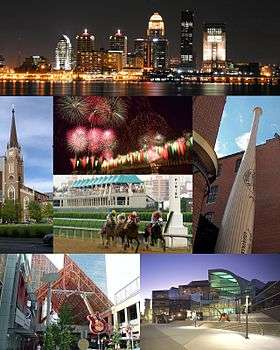Portland, Louisville
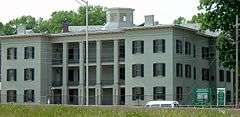
Portland is a neighborhood and former independent town northwest of downtown Louisville, Kentucky. It is situated along a bend of the Ohio River just below the Falls of the Ohio, where the river curves to the north and then to the south, thus placing Portland at the northern tip of urban Louisville. In its early days it was the largest of the six major settlements at the falls, the others being Shippingport and Louisville in Kentucky and New Albany, Clarksville, and Jeffersonville on the Indiana side. Its modern boundaries are the Ohio River along the northwest, north, and northeast, 10th Street at the far east, Market Street on the south, and the Shawnee Golf Course at the far west.
History
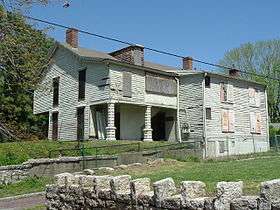
Gen. William Lytle II, the founder of Cincinnati, Ohio, owned a large amount of land just below the Falls of the Ohio and in 1811 laid out the settlement of Portland. He planned to sell the lots to finance his plan to build a canal around the Falls. Lytle authorized Joshua Barclay and Alexander Ralston to design the town, which featured a Northeast to Southwest street grid. The original settlement was between what is now 36th and 33rd Street along the Ohio River, which included a large wharf. The settlement quickly grew to the east in a Northwest to Southeast street grid, which noticeably contrasts to the East-West grid of adjacent areas of Louisville.
The advent of steamboats on the Mississippi occurred simultaneously with Portland's development, allowing the Ohio River to be used as a major freight shipping route in what was then the American Frontier. Portland was located just downstream from the only natural obstacle on the Ohio River, so all large boats traveling on the Ohio had to stop to move their freight by land around the Falls and reload them on another boat. With a captive audience and a need for freight hauling, Portland's Wharf flourished as numerous taverns, warehouses, and shipyards were built. By 1814 French immigrants from Alsace began populating the town.[1]
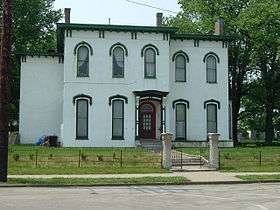
By 1817 the original street grid had run out of room and was expanded to 40th Street on the west and 13th Street on the east in 1817 to facilitate the additional growth. It quickly became a rival of Louisville and the nearer-by settlement of Shippingport. The three were first connected by road in 1818. This road, initially called the Louisville & Portland Turnpike, became Portland Avenue.
An important early home was the Squire Earick house (719 N. 34th Street), which was home of the first magistrate, and also used as the settlement's courthouse and jail. Another landmark was the Church of Our Lady now Good Shepherd Catholic Church, started in 1839 and the third building, built in 1873, still standing in 2010.
From 1826 to 1833, the Louisville and Portland Canal was built around the Falls, causing many of the warehouses and shipyards to close and shifting economic power on the Falls to nearby Louisville, although Portland would continue to grow as many French and Irish immigrants moved there. (The demonym "Hoosier" given to residents of Indiana since the early 1830s has been linked to the construction of the canal, allegedly because a contractor named Samuel Hoosier preferred Indiana workers over those from Kentucky, and they were therefore dubbed as "Hoosier's Men.") It was incorporated in 1834, but then annexed by Louisville in 1837 after a compromise by which the canal would be widened to handle larger ships but the new rail line going from Lexington to the Ohio River would go to Portland's wharf instead of Louisville's. However, after the new line collapsed into bankruptcy in 1840 having only reached as far as Louisville, Portlanders voted in 1842 to become independent again, although ten years later the area was annexed a second time.
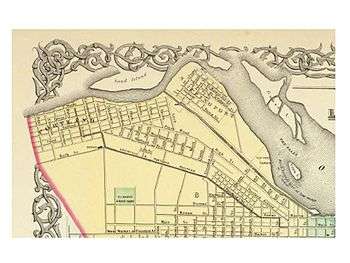
Although now just a neighborhood of the much larger Louisville, Portland would continue to flourish as a working class community through the 1930s, with residents working in many of the nearby factories. The largest Ohio River flood in recorded history occurred in 1937 and inundated all of Portland, with areas closest to the river nearly being wiped out. Plans began immediately to protect the area with a flood wall, but World War II occupied the priority of the government's engineers. Just eight years later in 1945 the second largest flood in Louisville's history occurred. In its aftermath all areas of Portland nearest to the river were razed, including the Portland Wharf, and a gigantic flood wall was built to a height three feet above the level of the 1937 flood. Both floods had driven many middle-class families from the area. Despite the loss of many of area's oldest buildings, portions of the neighborhood away from the flood wall were largely untouched by urban renewal, and retain a great number of pre-Civil War buildings. Although many older mansions exist in Portland, the vast majority of homes built in the area were shotgun houses.
Portland today
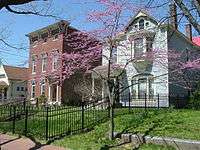
As of 2015, the estimated population of Portland is 11,810 . Portland was the only predominantly White neighborhood on Louisville's West Side. Prior to 1960, Blacks were effectively unable to live in the neighborhoods north of Broadway, which included Portland. Portland, though, had always been home to one of the earliest settlements of free, property-holding Blacks who co-existed as 10-15% of Portland's resident population according to Rick Bell, Portland historian. Archives of this community may be visited at the Portland Museum, 2308 Portland Ave. However, during White Flight areas to Portland's south and west became almost entirely Black.

In 2006, Portland was named by First Lady Laura Bush to be a Preserve America community. Communities designated through the program are allowed to use the Preserve America logo on signs and promotional materials and are eligible to apply for grants that will be administered by the U.S. Department of the Interior.
There are several futures plans to help revive parts of Portland, including the creation of a museum and arts district in the Portland Warehouse District (which sits just 2 blocks from Louisville's Museum Row), and opening several historic buildings to the public. There are also plans for the creation of several large parks along the Portland Waterfront. When complete, the Portland Wharf Park will bear a striking resemblance to Downtown Louisville's Waterfront Park. There are also plans to great a "Great Lawn West" just west of the 9th Street / I-64 interchange.
Attractions and historic sites
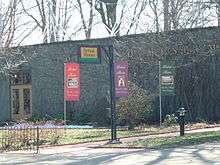
Portland is home to a large number of Louisville's most prominent historic landmarks and a large percent of the city's pre Civil War buildings. Although currently not open to the public, the United States Marine Hospital of Louisville is considered one of the most architecturally important historic sites in the US. Completed in 1847, it is widely considered the best remaining antebellum era hospital in the US and is the only remaining of the seven original hospitals built in the mid-19th century by the Marine Hospital Service. After sitting abandoned for several decades, the building's exterior has been fully restored to match its appearance in 1899, with the inside still being restored.

There are many other 19th century landmarks in Portland, including the Notre Dame du Port Church (1841) (now Good Shepherd Church), the Montgomery Street School (1852) and numerous privately owned mansion houses, many of which were built by steamboat captains. The entire Portland Historic District is listed on the National Register of Historic Places. In 1996 Louisville's first bike trail was opened along Portland's waterfront. The seven mile long River Walk has since been extending 20 miles to the Farnsley Morman Landing near Valley Station and is going to be part of a 110-mile long bike trail encircling Louisville. The River Walk also links Portland directly to Downtown Louisville and Shawnee Park. The Portland Library serves the neighborhood area.
In an attempt to revitalise the community, the Table, a pay-what-you-can restaurant, was started November 2015. The Table since then has exploded and was featured on food networks Diners Drive in and Dives show. The Table has provided gourmet, nourishing food for homeless people and encourages working instead of handouts.
Demographics
As of 2000, the population of Portland was 11,811,[3] of which 71.7% are white, 24.5% are black, 3.1% are listed as other, and 0.8% are Hispanic. College graduates are 3.3%, people without a high school degree are 46.3%. Females are 51.9% of the population, males are 48.1%. Households making less than $15,000 a year are 38.7%.
Originally settled by French and Irish immigrants, since WWII most of the original immigrant families left for the South End of Louisville, and Portland is now mostly populated by displaced rural Kentuckians of British Isles heritage. In 2000 less than 1% of Portlanders claimed French ancestry and only 10% claimed Irish ancestry. Over 20% of Portlanders claimed 'American' ancestry, which is the most common ancestry in the rural South.
Notable natives
Portland has been home to many notable people over the years:
- John James Audubon - world-renowned wildlife artist
- Mary Millicent Miller - first woman to be a licensed steamboat captain
- Howard Schnellenberger - college football coach at Oklahoma, Miami, Louisville, & Florida Atlantic
- Paul Hornung - former Heisman Trophy winner at Notre Dame and Hall of Fame Green Bay Packers football player
- Pee Wee Reese - former 10 time MLB all star in the 1940s-50s
- Martha Rofheart née Jones - Actress and writer grew up at 2120 Portland in the 1920s
- Steve Mings[4] - Former guitarist for Altered Addiction[5][6]
- Joe Lewis[6] - Former bassist for Altered Addiction[5]
Gallery
 The Church of Our Lady, completed in 1873
The Church of Our Lady, completed in 1873 The locations of the six early Falls settlements, as shown on a modern map
The locations of the six early Falls settlements, as shown on a modern map A map from the 1850s showing the streets of Portland, the slanted orientation is noticeably different than that of encroaching Louisville's
A map from the 1850s showing the streets of Portland, the slanted orientation is noticeably different than that of encroaching Louisville's Ongoing work to widen portions of the Louisville and Portland Canal
Ongoing work to widen portions of the Louisville and Portland Canal Squire Earick house, the oldest known surviving house in Portland
Squire Earick house, the oldest known surviving house in Portland A store in Downtown Portland
A store in Downtown Portland Old Portland Wharf
Old Portland Wharf Wall mural at 26th and Portland Ave
Wall mural at 26th and Portland Ave A historic home on 34th Street
A historic home on 34th Street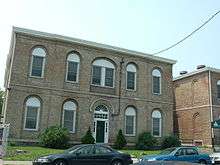 Montgomery Street School, completed in 1852
Montgomery Street School, completed in 1852 Portland Warehouse District
Portland Warehouse District The River Walk
The River Walk An Italianate style building at 32nd & Rudd
An Italianate style building at 32nd & Rudd Portland's Lannon Park
Portland's Lannon Park Pre Civil War homes on Rudd Ave
Pre Civil War homes on Rudd Ave Pre Civil War homes on Rudd Ave
Pre Civil War homes on Rudd Ave
References
- ↑ Burnett, Robert A. (April 1976). "Louisville's French Past". Filson Club History Quarterly: 10.
- ↑ "History of the Kentucky & Indiana Terminal Railroad". Retrieved 2007-05-24.
- ↑ "Community Resource Network". CRN Data. Archived from the original on May 11, 2008. Retrieved 2005-11-18.
- ↑ "Altered State on PureVolume". PureVolume. Retrieved 2016-05-25.
- 1 2 "Altered Addiction [OFFICIAL] on PureVolume". PureVolume. Retrieved 2016-05-25.
- 1 2 eMinor. "Altered Addiction(OFFICIAL) | Rock from Beechmont, KY". ReverbNation. Retrieved 2016-05-25.
External links
- Portland Museum
- Portland Now, Inc. (Portland's Neighborhood Association)
- Street map of Portland
- Public and Private Partnerships Target Portland Neighborhood Revitalization Strategy—Louisville.gov August 23, 2013
- Images of Portland (Louisville, Ky.) in the University of Louisville Libraries Digital Collections
- "Portland: City Served as Detour Point for Falls Freight and Travelers; Jim Porter Ruled the Wharf Taverns" — Article by Shawn M. Herron of The Courier-Journal
- "A Portrait of Portland; One of Louisville's oldest, poorest neighborhoods goes under the LEO microscope" — Article by Jonathan Meador of LEO Weekly
 |
Ohio River | Ohio River, Shippingport | Ohio River |  |
| Ohio River, Shawnee | |
Ohio River | ||
| ||||
| | ||||
| Shawnee | Russell | Downtown Louisville |
Coordinates: 38°16′09″N 85°48′39″W / 38.26920°N 85.81080°W
